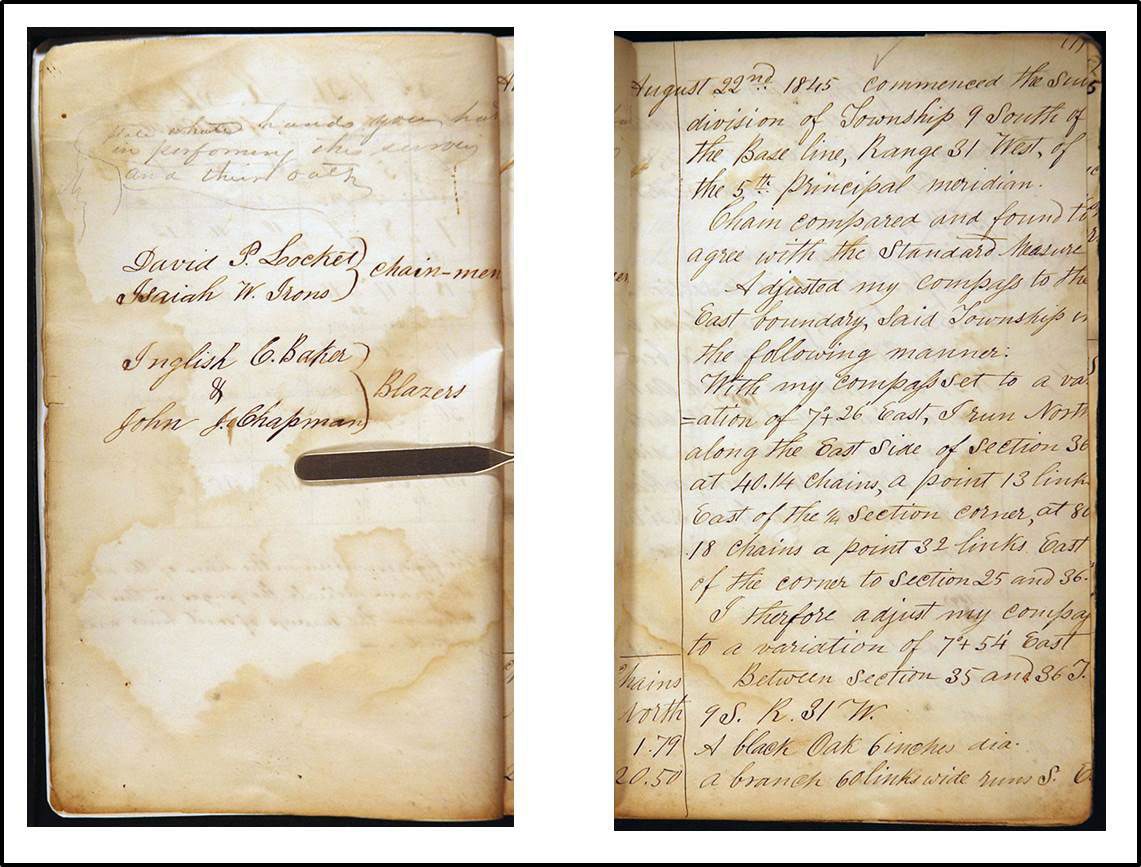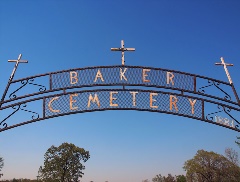While reviewing historical General Land Office (GLO) survey notes in an effort to locate potential references to the rare and endangered shrub pondberry (Lindera melissifolia), occasionally other interesting information in the survey notes catches ANHC Botanist Brent Baker’s attention. Recently, while he was reviewing GLO survey notes dated from August and September 1845 from the lower Cossatot River bottoms in southwestern Arkansas, he came across a person’s name which was familiar to him.
“I did a double take and then jumped out of my chair to tell several coworkers,” Brent explains. “I almost couldn’t believe it!”
The surveyor had listed the names of the two chainmen and two blazers he’d hired to work on his crew in that particular area (Land Office surveyors usually hired locals to work on their temporary survey crews, see “GLO Notes: An Invaluable Resource for Ecologists”). One of the blazers was listed as “Inglish C. Baker”. Brent instantly recalled that his great-great-great-grandfather’s name was English Calvin Baker and that English had lived only about 15 miles from the survey area, near the Cossatot River, upstream in the southern Ouachita Mountains.

Brent’s fourth-great-grandparents (English’s parents), born in Tennessee and Kentucky, had moved in the mid-1810s to what at the time was still actually part of the Missouri Territory (Arkansas became a territory in 1819 and a state in 1836), and had ultimately settled near the Cossatot River, near the present-day Cossatot River State Park-Natural Area. The Baker family, among some of the earliest pioneer families to settle in the Ouachita Mountains, is deeply entrenched in the history of the area, and several local features and landmarks bear their name.
 These include Baker Creek, a tributary of Harris Creek which flows into the Cossatot River; Baker’s ford, the old low-water crossing of the Cossatot River below the current Highway 278 bridge; the historic Baker community, church, and cemetery (in which English’s is the oldest marked grave in the cemetery); as well as the natural sulfurous springs discovered by English’s father (while trailing buffalo, according to family lore) and the associated but now defunct resort community of Baker Springs which sprang up at the site. Although Brent is a couple of generations removed from the area (his grandparents moved away when his father was an infant), numerous Baker descendants still live in the region.
These include Baker Creek, a tributary of Harris Creek which flows into the Cossatot River; Baker’s ford, the old low-water crossing of the Cossatot River below the current Highway 278 bridge; the historic Baker community, church, and cemetery (in which English’s is the oldest marked grave in the cemetery); as well as the natural sulfurous springs discovered by English’s father (while trailing buffalo, according to family lore) and the associated but now defunct resort community of Baker Springs which sprang up at the site. Although Brent is a couple of generations removed from the area (his grandparents moved away when his father was an infant), numerous Baker descendants still live in the region.
 Brent wondered if this Inglish C. Baker was really his third-great-grandfather. The spelling of the first name was certainly odd, but it’s possible the surveyor simply misspelled it. After all, what are the odds that there were two Baker men with phonetically identical first names and the same middle initial living in such close proximity that long ago? Brent checked family records and found that his English had turned 17 years old in August of 1845, actually during the time period of the surveys documented within these notes. There doubtfully would have been secondary schools like high school in this rural and remote part of the still infant frontier state and there also probably weren’t a lot of jobs to be had in the area either. Brent’s ancestors had been primarily subsistence farmers. It’s not hard to imagine a local, able-bodied young man not yet married or with a farm of his own jumping at the chance to work a few months for a land surveyor to earn a little money. Given the proximity to English’s home, his age, and the similarity of the names, it seems far too coincidental for this blazer and Brent’s third-great-grandfather not to have been one-in-the-same.
Brent wondered if this Inglish C. Baker was really his third-great-grandfather. The spelling of the first name was certainly odd, but it’s possible the surveyor simply misspelled it. After all, what are the odds that there were two Baker men with phonetically identical first names and the same middle initial living in such close proximity that long ago? Brent checked family records and found that his English had turned 17 years old in August of 1845, actually during the time period of the surveys documented within these notes. There doubtfully would have been secondary schools like high school in this rural and remote part of the still infant frontier state and there also probably weren’t a lot of jobs to be had in the area either. Brent’s ancestors had been primarily subsistence farmers. It’s not hard to imagine a local, able-bodied young man not yet married or with a farm of his own jumping at the chance to work a few months for a land surveyor to earn a little money. Given the proximity to English’s home, his age, and the similarity of the names, it seems far too coincidental for this blazer and Brent’s third-great-grandfather not to have been one-in-the-same.
 Brent has always been interested and fascinated by history and has enjoyed learning the tidbits of information he’s garnered form the GLO notes about the people and their lives during the time of the Arkansas Territory and early days of Arkansas Statehood, in addition of course to the valuable natural history information the notes contain.
Brent has always been interested and fascinated by history and has enjoyed learning the tidbits of information he’s garnered form the GLO notes about the people and their lives during the time of the Arkansas Territory and early days of Arkansas Statehood, in addition of course to the valuable natural history information the notes contain.
“But it was certainly a thrill to unexpectedly see my ancestor’s name in the 172-year-old document,” says Brent. “It’s amazing to think that someone in my family may have played even a small role in helping survey and map our state and collect some of the data that we now use to help guide our conservation work today. It feels a bit like it’s come full circle. I still have a lot of books of survey notes yet to review and I look forward to finding out what additional surprises they may hold, both botanical and historical.”
Brent isn’t the only person on staff with a story about a relative and the GLO survey. As a child, Theo Witsell remembers attending the 100th birthday party for his great-great uncle Eldridge Douglass and hearing the story of how, in 1921 Douglass rediscovered the original witness trees that marked the initial point of the Louisiana Purchase survey. Today this area has been designated a National Historic Landmark and is protected as both a state park and a state natural area. The State Park brochure for the area tells the same story that Theo heard as a child.
Photo 1 — Two-page spread from a book of original GLO survey notes recorded by G. Pendleton, deputy surveyor, in August 1845. This survey was conducted in the lower Cossatot River bottoms in present-day Sevier County, Arkansas. One of the survey crew blazers was listed as "Inglish C. Baker," which very likely was ANHC Botanist, Brent Baker's third-great-grandfather English Calvin Baker, who lived nearby and would have turned 17 during the period of the survey documented within these notes.
Photo 2 — Entrance sign to Baker Cemetery in Polk County, Arkansas. The cemetery is located adjacent to the historic Baker Church in the area of the old Baker community. Photo by Brent Baker.
Photo 3 — Old newspaper clipping showing the Baker Springs resort circa 1915. The resort was situated near natural sulfurous springs originally discovered in the early 1800s by ANHC Botanist, Brent Baker's fourth-great-grandfather, namesake of the springs and subsequent resort.
Photo 4 — A segment of a USGS topographic map showing a portion of Howard County, Arkansas, near the Cossatot River. Baker Creek is a tributary of Harris Creek, which in turn flows into the Cossatot River. Baker Springs is the site of a historic resort community located near natural sulfurous springs. Additionally, although not labeled here, the road crossing of the Cossatot River in the lower portion of the map roughly coincides with the original low-water crossing called Baker's ford. All were named after ANHC Botanist Brent Baker's ancestors who settled nearby in the early 1800s.
Main photo — English Calvin Baker's tombstone in Baker Cemetery in Polk County, Arkansas. Baker was the third-great-grandfather of ANHC's Botanist Brent Baker. English's grave is the oldest marked grave in the cemetery. Photo by Brent Baker.
